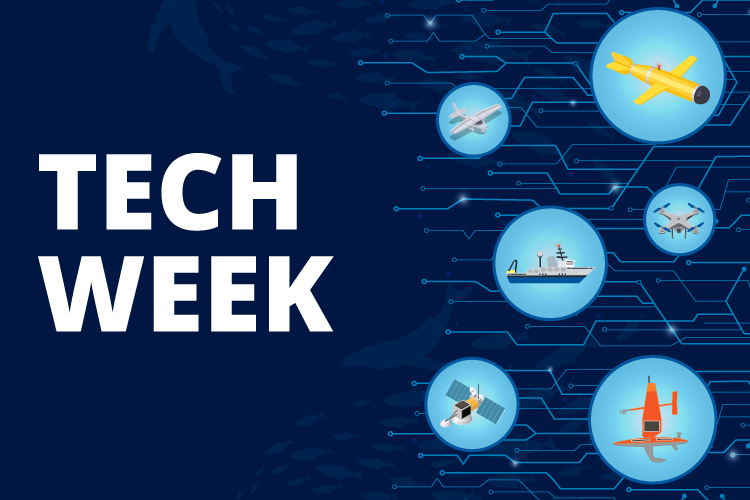NOAA scientists use many technologies to collect and analyze the data needed to manage our ocean resources and habitats. These technologies help us explore remote ocean areas, study endangered species, and ensure we have the information needed to make informed management and conservation decisions. This allows us to better manage fisheries and support our coastal communities.
Join us for Technology Week (January 13-17, 2025) to examine some of these technologies, many of which are powered by funding from the Inflation Reduction Act.
How NOAA Fisheries uses technology
We are a leader in the use of advanced technologies, but what exactly do we do?
Some ocean creatures are difficult to study because they live in remote habitats or have complex life cycles. And to study unique creatures, scientists sometimes need to use unique tools. Our scientists use a range of advanced technologies to collect and analyze data and better understand the science behind the health of ecosystems and marine life. Get familiar with the technology we use to support our mission by reading the features below.
Discover the technologies used by our scientists to study marine species and the environment
Unmanned systems
Unmanned systems allow us to access remote or hard-to-reach places. They can be deployed by air, on the ocean surface, and beneath the waves, complementing traditional methods of data collection and expanding our ability to conduct important research.
Gliders: collecting data on ocean health
Autonomous vehicles, like gliders, give us crucial new information about what’s happening in the depths of the ocean. Watch the video below to learn how gliders are collecting key data on ocean health.
Learn how gliders collect ocean data
How underwater drones are transforming fishing data collection in remote areas
Remote underwater gliders – or underwater drones – offer opportunities for all kinds of data collection and oceanographic research. Learn how gliders are used to study Antarctic krill, the foundation of the region’s food web.
Listen to the Antarctic Glider Research Podcast
Using drones and tags to study Rice’s whales
NOAA Fisheries and partners deployed suction tags from drones to get an up-close look at the lives of these endangered whales.
Learn about Rice’s whale studies using drones and suction tags
Glider Piloting with Jen: All Systems Work!
NOAA scientists deploy three underwater gliders to collect important data on Antarctic krill.
Learn more about glider research with Jen Walsh
Long-running sea scallop investigation diversifies for future
Our sea scallop survey has provided data on the status of the population since 1979. Since then, we have used cutting-edge technologies to adapt and diversify our survey methods.
Learn more about the technologies used for scallop inventory.
Optical
“Optics” refers to the collection, storage and processing of images on a large scale, which allows validation of other data sources. Optics plays an important role in helping us advance data collection using unmanned systems.
Cameras show researchers where Atlantic salmon go to beat the heat
Researchers successfully used cameras flown from a helicopter to map surface water temperatures in Maine’s Narraguagus River. This is an important step toward conserving the habitat of endangered Atlantic salmon and other migratory fish.
Learn more about research to support conservation of Atlantic salmon habitat
AI meets aquaculture to study Hawaiian monk seal interactions with net enclosures
NOAA Fisheries and Blue Ocean Mariculture are leveraging technology to study Hawaiian monk seal interest in aquaculture net pens in Hawai’i.
Learn more about Hawaiian monk seal research
Infrared imagery helps paint first-ever color portrait of Narraguagus River thermal habitats
Valérie Ouellet launched a pilot project using specialized infrared camera equipment and a helicopter to map surface temperatures along an entire river system in Maine. The river provides habitat for Atlantic salmon and other migratory fish, an endangered species.
Learn more about using infrared cameras to study Atlantic salmon habitat.
Passive and active acoustic monitoring
Sound is the primary means by which many marine animals communicate and perceive information. We record and analyze natural underwater sounds with passive acoustic monitoring. We deploy echo sounders and analyze the resulting sound waves using active acoustics. This information helps us detect and characterize the physical and biological characteristics of ocean areas.
Listening to the Whales: Using Passive Acoustic Monitoring to Track North Atlantic Right Whales
Whales use sound to communicate and find food. Passive acoustic monitoring uses sound to determine when and where whales are in the ocean. Thanks to new technologies, we can track them in near real time.
Watch the video on passive acoustic monitoring and North Atlantic right whales
Monitoring endangered North Atlantic right whales in near real time through sound, air and sea
NOAA Fisheries uses the latest technologies, such as passive acoustic monitoring, to detect endangered North Atlantic right whales in near real time and support the recovery of the species.
Discover the latest technologies used to study North Atlantic right whales.
Ocean gliders listen to whales off Oregon to test new ways to count them
Three small autonomous underwater gliders called Seagliders have been cruising the ocean off the Oregon coast in recent months. They were listening to underwater sound as part of experimental research to find new ways to track and count whales and other marine mammals.
Learn about underwater gliders used to detect marine species
It’s a boat, it’s a plane, it’s a passive acoustic ocean glider!
Cetacean studies specialist Selene Fregosi explains how underwater gliders help us listen to whales.
Read Selene’s science blog on underwater gliders
Remote sensing, satellite data and artificial intelligence
“Remote sensing” refers to the science of obtaining information about land and oceans from images acquired remotely, such as satellite imagery and aerial photography.
Satellite tags help confirm leatherback turtle feeding grounds
Scientists are discovering evidence of critical feeding grounds for endangered leatherback turtles along the U.S. Atlantic coast by studying their movement behavior using satellite labels.
Learn about the satellite tags used for leatherback turtle research
Unmanned vehicles show promise for ocean data collection in hard-to-reach areas
A team of ocean researchers has sent a submarine-shaped unmanned vehicle filled with scientific electronics to areas of offshore wind farms off southern New England. This could be an important step towards a safe and effective solution for monitoring marine life and their habitats in places where our larger research vessels and aircraft cannot operate.
Learn more about using unmanned vehicles to monitor marine life and their habitats.
Omics
“Omics is the analysis of genetic material obtained from an organism. This genetic material could be extracted directly from an organism or taken from the biological traces an organism leaves behind, known as environmental DNA analysis. “Omics uses a suite of cutting-edge technologies to identify organisms, understand their behavior and predict changes in their population structure. This allows NOAA Fisheries to obtain critical data more efficiently and less expensively.
Environmental DNA could be a new way to measure the amount of fish present
NOAA Fisheries scientists and partners show that it is possible to estimate fish biomass of multiple species at the same time using environmental DNA.
Discover the new approach to studying fish DNA
Genetic diversity of Alaskan red king crab could ensure resilience to climate change
New genetic research on the Alaskan red king crab reveals previously unknown diversity between different regions, suggesting the species is more resilient to climate change and changing ocean conditions.
Learn more about genetic research on the Alaskan red king crab


